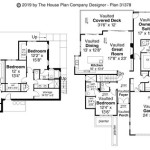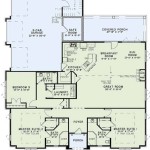How To Find The Floor Plan Of A Property
Locating a floor plan for a property can be crucial for various reasons, including planning renovations, visualizing furniture placement, assessing property value, or simply satisfying curiosity about the layout of a space. While obtaining a floor plan might seem challenging, several avenues exist to acquire this valuable document. This article details the methods and resources available to find a floor plan for a property, offering a comprehensive guide for individuals seeking this information.
The availability of a floor plan often depends on factors such as the age of the property, the type of property (e.g., single-family home, apartment, commercial building), and local regulations concerning public records. Older properties may not have readily available floor plans, while newer construction often requires them as part of the building permit process. Similarly, details related to apartments can be more difficult to obtain compared to single-family houses due to privacy concerns and management company policies.
Exploring Online Real Estate Listings and Databases
One of the most accessible and convenient methods for finding a floor plan is through online real estate listings. Websites such as Zillow, Trulia, Realtor.com, and Redfin frequently include floor plans in their property listings. These platforms are designed to provide comprehensive information to potential buyers, and floor plans are increasingly recognized as a valuable asset in showcasing a property. When searching for a property on these sites, carefully review the listing details and media sections. Look for tabs or sections labeled "Floor Plan," "Layout," or "Virtual Tour," which often contain the desired information.
Furthermore, some specialized real estate databases and architectural websites may maintain archives of floor plans. These resources might require a subscription or a one-time fee for access, but they can be particularly useful for locating floor plans for unique or historic properties. Websites like Architectural Designs and e-Plans offer a wide variety of pre-designed floor plans, though finding a specific existing property's plan on these platforms is less likely unless it was custom-built based on one of their designs.
When reviewing online listings, it is important to verify the accuracy of the floor plan. While real estate agents strive to provide accurate information, errors can occur. Cross-referencing the floor plan with other details in the listing, such as room dimensions and photographs, can help ensure its reliability. Additionally, if possible, compare the online floor plan with information obtained from other sources, such as property tax records or building permits.
Another avenue to explore is the website of the building’s management company, especially for apartments or condominiums. These companies frequently maintain records of unit floor plans for maintenance, renovation, and marketing purposes. Contacting the management company directly and inquiring about the availability of a floor plan could prove fruitful.
Consulting Local Government and Public Records
Local government agencies, such as city halls, county courthouses, and building departments, are valuable sources for obtaining property information, including floor plans. Building permits, construction documents, and property tax records are often maintained by these agencies and may contain floor plans. Access to these records is typically governed by local regulations and may require a formal request.
The process for accessing public records varies depending on the jurisdiction. In some areas, property records are available online through the county assessor's or recorder's website. These online databases often allow users to search for properties by address or parcel number and view scanned images of documents, including floor plans. However, older records may not be digitized and may require an in-person visit to the relevant government office.
When requesting information from a local government agency, it is important to provide accurate and complete details, such as the property address, parcel number, and owner's name. Be prepared to pay a fee for document retrieval and copying. The time required to process the request can vary depending on the agency's workload and the availability of the records. It is advisable to contact the agency in advance to inquire about the specific procedures and fees involved.
Additionally, if the property has undergone renovations or additions, documentation regarding those changes might be on file with the local building department. These records could include updated floor plans reflecting the modifications made to the original structure. Investigating permit history can be an effective way to find a floor plan that reflects the current layout of the property.
It is important to note that accessing property records is subject to privacy laws and regulations. Some information may be redacted or withheld to protect the privacy of the property owner. However, in most jurisdictions, basic property information, including floor plans, is considered public record and is accessible to anyone.
Engaging Professionals: Architects, Appraisers, and Real Estate Agents
If the above methods prove unsuccessful, engaging professionals in the real estate and architectural fields can be a viable option. Architects, appraisers, and experienced real estate agents often have access to resources and networks that can aid in locating a floor plan for a property. Hiring an architect to create a new floor plan, while costly, can also provide a accurate blueprint of the property.
Architects, especially those who specialize in residential design, may have access to historical plans or be able to recreate a floor plan based on their expertise and understanding of building design principles. They can conduct site visits, measure the property, and create a detailed floor plan that accurately reflects the current layout. While this option involves a professional fee, it can be particularly useful for older properties where floor plans are not readily available.
Real estate appraisers, who are responsible for assessing the value of properties, often rely on floor plans to determine the square footage and layout of a building. They may have access to floor plans from previous appraisals or be able to obtain them from other sources. While they cannot directly provide access, they may give the original source if they obtained the floorplans through public records or online channels.
Experienced real estate agents can also be valuable resources. They often have access to Multiple Listing Services (MLS), which may contain floor plans for properties that have been listed for sale in the past. Additionally, they may have contacts within the local government and construction industries who can assist in locating floor plans. Agents are particularly useful in areas with established real estate networking and are more likely to have come across the property previously.
Before engaging any professional, it is important to verify their credentials and experience. Check their licensing status and read online reviews to ensure they have a good reputation. Obtain a written agreement outlining the scope of work, fees, and deliverables. Clearly communicate your needs and expectations to ensure that the professional understands your objective and can effectively assist you in finding the floor plan you need.
One should also consider contacting previous property owners. While this may not be feasible in all situations, the previous owners may have a copy of the floor plan from when they purchased or renovated the property. Contacting them through social media or public record information might yield results, especially for newer builds where documentation is more likely to be retained.
Ultimately, finding a floor plan for a property requires a combination of resourcefulness, patience, and persistence. By exploring online resources, consulting local government agencies, and engaging professionals, individuals can increase their chances of successfully obtaining the desired document.

10 Ways To Find The Floor Plan Of A House

10 Ways To Find The Floor Plan Of A House

9 Ways To Find Floor Plans Of An Existing House Archid

How To Find Floor Plans Blue Prints Of Your House

How To Find Floor Plans Blue Prints Of Your House

How To Measure Calculate Square Footage Roomsketcher

10 Ways To Find The Floor Plan Of A House

How To Read A Floor Plan With Dimensions Houseplans Blog Com

How To Find Floor Plans Blue Prints Of Your House

How To Find Property Lines And Keep From Calling An Expensive Surveyor Armchair Builder Blog Build Renovate Repair Your Own Home Save Money As Owner
Related Posts








